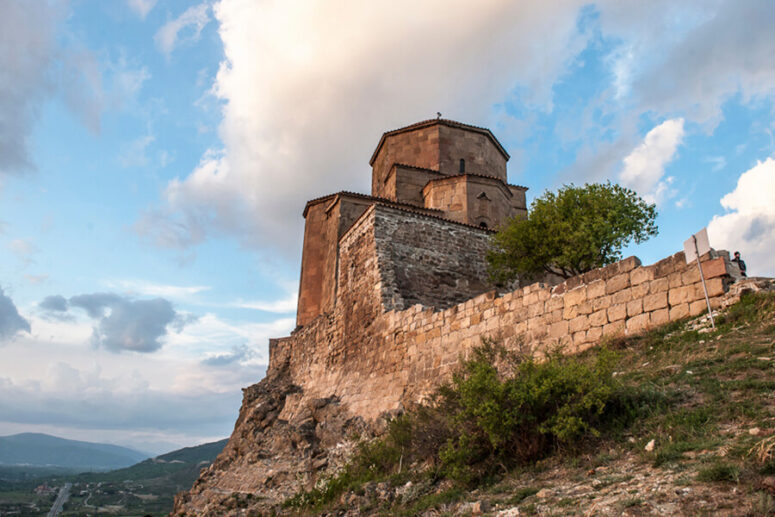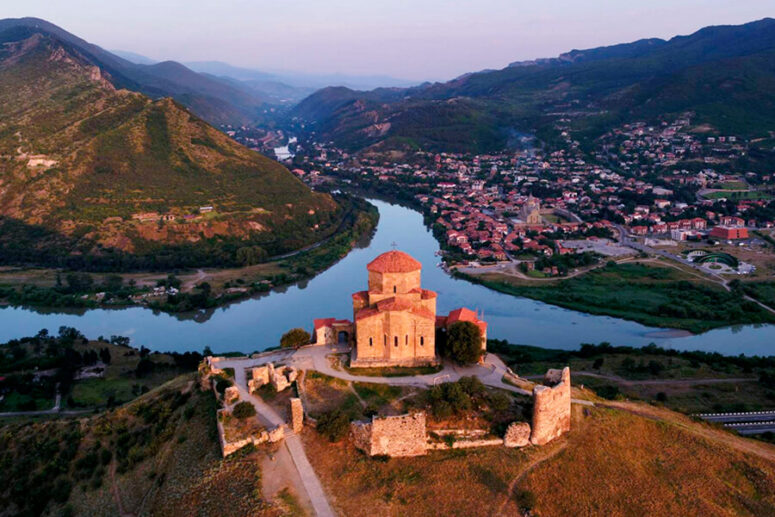
Jvari (translated as “Cross”) is a monastery of the Georgian Orthodox Church, located 21 km from the capital of Georgia, Tbilisi. It is located on the top of Mount Armazi, near the city of Mtskheta, the ancient capital of Iberia. According to historical sources, it was at this place that St Nina, Equal to the Apostles, erected a cross in the 4th century, symbolizing the victory of the Christian faith over paganism. This cross, revered as miraculous throughout the Christian Caucasus, has given the area its name. Before the construction of the temple, St Nina’s cross, visible not only from Mtskheta, but also far outside the city, was an object of worship and pilgrimage.

Jvari – Monastery of the Holy Cross
The Monastery of the Cross (Georgia) appeared next to the currently ruined ancient temple that was already standing on the mountain in 545. A larger church, consecrated in honor of the Exaltation of the Holy Cross, was erected in late 6th — early 7th century. It is built on top of a rocky massif and looks as its natural extension, forming the center of the surrounding landscape. This church has never been rebuilt and now looks the same as 15 centuries ago. It was built for a full due, using a technique where one stone is “locked” inside another, making the setting more durable with time.
Influence of Byzantium
The church was built in the form of a tetraconch (an equilateral cross inscribed in a square, with a dome in the middle). Such an architectural treatment looks unusual and appears to be an unmistakable sign of Byzantian influence, since Georgian temples at that time were, as a rule, basilicas without domes.
The eastern and southern walls of the temple are decorated with sculptural reliefs and ornaments. On the edges of the altar apse (a semicircular ledge) there are three reliefs with images of churchwardens – the founders and decorators of the temple.
On the pediment there are images of angels holding a wreath with a cross of equal rays, expanding from the center. Crosses of this design are characteristic of the era of Constantine the Great.
Elements of ancient mosaics have been preserved on the walls of the temple.
History of the Temple and Monastery
At the end of the 7th century, the Arab invasion ended with the formation of the Tbilisi Emirate. In the middle of the 9th century, the ruler Isaak ibn Ismail ibn Shuab (Georgians called him Sohak) converted to Christianity, refused to pay tribute to Persia and tried to secure the independence of the emirate, but in 853 Sohak’s army was defeated and Tbilisi (Tiflis) was burned. The same fate befell Jvari Monastery. The Persians burned down the temple and took with them the wooden cross. Medieval historian Leonti Mroveli mentions this episode in his “Chronicle. He writes that after capturing the cross, the invaders suffered a serious illness, so they returned the shrine back and put it back in its original place. It happened ca. 960.
The monks continued to live in the destroyed temple, but their numbers were few, which did not allow them to completely restore the buildings destroyed by the Persians.
In the 17th-18th centuries, the raids of the mountaineers on Georgia became more frequent, resulting in walls being erected around the monastery. The temple then became a refuge for monks and the local population.
In Soviet times, the area around Jvari belonged to a pioneer camp until 1992, when it was returned to the reviving monastery.

Monastery Praised by a Poet
Ancient legends speak of various miracles associated with the cross, making the monastery on the mountain a place of pilgrimage, attracting since the 7th century pilgrims from the Caucasus and all over the world. It was this place that was sung by the Russian poet M. Lermontov. Inspired by the beauty of the temple and the area, he begins his famous poem Mtsyri (Georgian: Novice) with beautiful words describing the two rivers of Aragva and Kura merging together “like two embracing sisters” at the foot of a mountain where a monastery stands “with pillars of a collapsed gate, towers and the church vault”.
Jvari Monastery Today
From the entire monastery complex, only the restored temple of the Exaltation of the Holy Cross and the ruins of the first temple with the monastery walls and towers remain. The octagonal pedestal of that very ancient wooden cross can still be seen in the center of the temple.
The cypress cross now standing on the pedestal was installed in 2009 and skillfully decorated with scenes from the Gospel. Unfortunately, the traces of the original worship cross have been lost. Services in the temple are performed only on holidays.
The monks live nearby, but their territory is completely closed to outsiders.

Erecting churches on mountain tops is a tradition in Georgia where people believe that people should work for the Lord and climb the mountain on foot to come to the temple. During the ascent, one can stop at the spring of St Nina, whose water is believed to have healing properties.
In 1994, the Jvari Monastery (Mtskheta) became a UNESCO World Heritage Site. Restoration work is constantly being performed here now, creating the unique conditions needed for the preservation of particularly valuable fragments of the ancient temple.
Translated by The Catalogue of Good Deeds
Source: https://obitel-minsk.ru/chitat/den-za-dnyom/2021/monastyr-dzhvari-v-gruzii







